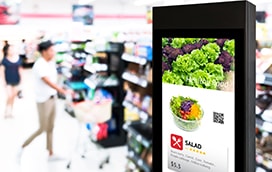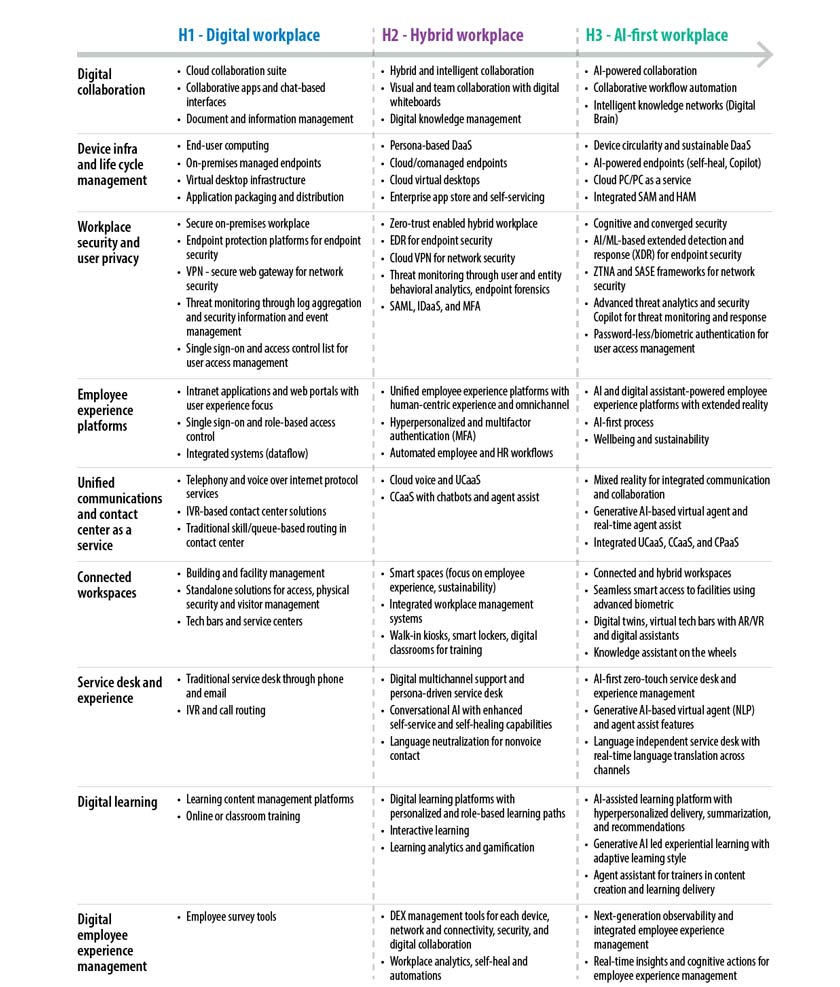Digital Workplace Services
The world of work is undergoing a seismic shift, thanks to rapid technological changes and evolving societal expectations. While enterprises integrate generative AI responsibly to become AI-first, human-centricity remains central for improving employee experiences.
Evolution of digital workplace services across the three horizons (H1 to H3)
H3
AI-first workplace
Key patterns
Digital collaboration
- AI-powered intelligent collaboration (transcriptions, actions, copilot)
- Agentic systems and workflows
- Intelligent knowledge networks (digital brain)
Device infra and life cycle management
- Device circularity and sustainable DaaS
- AI-powered endpoints (self-heal, copilot)
- Cloud PC/PCaaS
- Integrated SAM and HAM
Workplace security and user privacy
- AI/ML-based extended detection and response (XDR)
- ZTNA and SASE framework for network security
- Advanced threat analytics, security copilot
- Password-less/biometric authentication for user access management
Employee experience platforms
- AI and virtual assistant-powered platforms with mixed reality experience
- Multimodal interactions and responsible AI
- AI-first intelligent processes
Unified communications and contact center
- Mixed reality integrated communication and collaboration
- Converged platforms for UCaaS, CCaaS, and industry extensions with CPaaS
- Generative AI-based virtual agent and real-time agent assist
Connected workspaces
- Connected and sustainable workspaces (focus on sustainability and overall IEQ)
- Seamless smart access to facilities using advanced biometric
- Digital twins, virtual tech bars with AR/VR and digital assistants
Service desk
- AI-first virtual IT assistant and experience management
- Generative AI based virtual agent with contextual intelligence and cognitive actions
- Agent-assist features like digital nudges, call summarization, smart knowledge assist for resolution
- Real-time language translation across channels
Digital learning
- AI-assisted learning platform with hyperpersonalized delivery, summarization, and recommendations
- Digital learning assistants — experiential learning, adaptive learning style
- Agent assistance for trainers in content creation and learning delivery
Digital employee experience management
- Integrated digital employee experience management with end-to-end observability and cognitive actions
- Digital experience analytics based on correlation of experience-related telemetry from end-user computing devices, applications, network, and security
- Experience management office to drive continuous experience improvement
- DEX on wearables and IoT devices
H2
Hybrid workplace
Key Patterns
Digital collaboration
- Hybrid and team collaboration
- Collaborative apps and digital whiteboards
- Digital knowledge management
Device infra and life cycle management
- Persona-based DaaS
- Cloud/co-managed endpoints
- Cloud virtual desktops
- Enterprise app store and self-servicing
Workplace security and user privacy
- Endpoint detection and response
- Cloud VPN and zero trust
- Threat analytics, endpoint forensics
- SAML, iDaaS, MFA for user access management
Employee experience platforms
- Unified employee experience platforms with human-centric experience and omnichannel
- Hyperpersonalized and MFA
- Automated employee and HR workflows
Unified communications and contact center
- Cloud voice and UCaaS
- CCaaS with chatbots and agent assist
- Intelligent routing (AI/ML)
Connected workspaces
- Smart spaces (focus on employee experience, health and wellness)
- Integrated workplace management systems
- Walk-in kiosks, smart lockers
Service desk
- Digital omni-channel support (chat, email, ITSM)
- Persona-driven intelligent chatbots (AI intent-based) for self service
- Language neutralization for non-voice contact
Digital learning
- Digital learning platform with personalized learning paths and interactive learning
- Digital classrooms for training
- Learning analytics and gamification
Digital employee experience management
- Digital Experience Management (DEX) tools with proactive monitoring and remediation for devices, network and connectivity, digital collaboration, and security
- Joiners, movers, and leavers process automation to enhance experience
- Integrated XLA dashboards to monitor and action employee experience-related impacts
- AR solutions for faster remote-assist support
H1
Digital workplace
Key Patterns
Digital collaboration
- Cloud collaboration suite
- Collaborative apps and chat-based interfaces
- Document and information management
Device infra and life cycle management
- Device life cycle management
- Unified endpoint management
- Virtual desktop infrastructure
- Application packaging and distribution
Workplace security and user privacy
- Endpoint protection platforms
- VPN for remote access
- Threat monitoring using logs and SIEM
- SSO and ACL for user access management
Employee experience platforms
- Intranet applications and UX-driven web portals
- SSO and RBAC
- Integrated systems (data flow)
Unified communications and contact center
- Cloud VoIP services
- IVR-based contact center solutions
- Skill/queue-based routing in contact center
Connected workspaces
- Building management (focus on occupancy and operational efficiencies)
- Standalone solutions for access, physical security, and visitor management
- Tech bars and service centers
Service desk
- Multichannel service desk — phone, email and ITSM SaaS platforms
- Automated interactive voice response
Digital learning
- Digital platform for learning content management and delivery
- Online or classroom-based training
Digital employee experience management
- Employee survey tools
- NPS-based experience reporting (periodic)
Key trends across digital workplace services subdomains
H1 — Cloud powered collaboration
- Higher adoption of evergreen cloud platforms
- Modernization of legacy systems
- Video conferencing applications for a diverse remote workforce
- Focus on “single platform” productivity tools for Teams
- Work anywhere, anytime collaboration with asynchronous capabilities
- Event platforms with tracking and managing capabilities for hybrid audiences
- Unified platform to complete tasks without switching contexts
H2 — Hybrid work collaboration
- Intelligent conversational chatbots powered by natural language processing (NLP) and continuous learning capabilities
- Integrated platforms utilizing a wide range of functional application programming interfaces (APIs)
- Co-creation workspaces designed for real-time interactions
- Focus on findability using enhanced search
- Efficient auto categorization and tag management capabilities
- AI-powered collaboration tools for frontline workers
- Enhanced customer experience with process automations
- Integrated and personalized experiences based on workforce persona and well-being
- Visual collaboration platforms with canvas features
H3 — AI-first collaboration
- Digital assistants powered by generative AI enhancing user experience
- Task-centric work hubs integrating workplace applications
- Intelligent knowledge networks to assimilate data into knowledge
- AI-driven mechanisms to collaborate with findable and actionable knowledge
- Collaborative tools incorporated with guided attention capabilities
- Immersive mixed reality experience — mesh and metaverse
- Tools powered by AR/VR and XR experiences
- Co-audit assistant with fact checking capabilities for AI-generated content

AI-powered assistants can address issues such as communication and collaboration gaps, information misinterpretation, inefficient time management, and constant distractions. These user-centric tools can help prioritize workload, personalize interactions, handle repetitive tasks, and learn from customer interactions, thus boosting employees’ productivity.
View more
Generative AI tools can help enterprises organize and mine their existing content for insights, making it easier for employees to interrogate both the content and its metadata so that they can explore the organization’s knowledge graph more effectively. We expect this trend to continue, and for it to foster a culture of continuous learning.
View moreH1 — End-user computing
- Corporate-owned Windows-based desktops, laptops, and thin clients
- Endpoints with limited access for remote work and bring-your-own-device (BYOD)
- On-premises manual device provisioning and custom images
- Patch management designed for corporate local area network (LAN) and decentralized (Windows Server Update Services - WSUS)
- Application provisioning through packaged and manual installation or distribution
- Active directory group policy object (AD GPO)-driven controls and security for policy management
- Virtualization (virtual desktop infrastructure - VDI) with on-premises client-owned published applications and desktops
- Centralized print server (local or on-premises)
- Reactive device monitoring and support
H2 — Cloud-managed endpoints
- Multitouch-enabled devices, multioperating system (OS) support, and purpose-built peripherals as device as a service (DaaS)
- Flexibility to adopt BYOD and refurbished laptops (sustainability), smart lockers, and vending machines for peripherals
- Cloud-based device provisioning (Windows Autopilot), comanaged workloads (partial shift to cloud), and adoption of default OS images
- Cloud-based patching for first-party (OS) updates and limited third-party (application) patching
- Hybrid app store for self-service application provisioning
- Coexistence of cloud policies and AD GPO for policy management
- Cloud virtual desktop
- Follow-me print solution
- Digital experience tools for proactive monitoring and automation
H3 — AI-powered endpoints
- AI-powered edge computing and sustainable hardware (device circularity)
- Persona-aligned devices, 5G connectivity, and expansion of virtual service bar to include a virtual IT shop
- AI-powered endpoint analytics, cloud-native unified endpoint management, declarative device management, and user-driven self-provisioning
- Cloud-based automated patch testing and deployment for OS and third-party applications, integrated threat and vulnerability management
- Cloud-based app store for self-service application provisioning
- Cloud-based device security and policy enforcement
- Cloud PC (software as a service) and cloud boot for direct login to virtual desktops
- Cloud print
- AI for IT operations (AIOps) observability and remediation service, AR-based remote assistance
- Generative AI chatbot for assisted self-service

Sustainable hardware is central to organizational strategies. Pure device as a service (DaaS), which includes comprehensive device life cycle management, has become standard practice. Organizations are now embracing ecofriendly practices throughout the hardware life cycle, from procurement to disposal. This approach is crucial for enterprises aiming to lower emissions and achieve net-zero targets.
View more
AI can analyze user requirements and optimize device settings and resources through intelligent provisioning, where user behavior analytics and personalization tailor device experiences based on individual preferences and usage patterns. AI also detects threats, anomalies, and policy violations, initiating appropriate response actions.
View moreH1 — Secure on-premises workplace
- Installed antivirus software on individual devices, updated signatures regularly, and scanned for malware
- Used signature-based tools to detect and remove malware
- Implemented host-based intrusion prevention systems to detect and block attacks
- Used traditional virtual private networks with client software and passwords to secure remote access
- Used on-premises appliances to monitor and control web traffic
- Disabled USB ports or used software to block unauthorized USB device access
- Collected logs from individual devices and servers using system log (syslog) or simple network management protocol
- Managed access control lists on individual devices and servers to control access
H2 — Zero-trust enabled hybrid workplace
- Endpoint protection platform and endpoint detection and response solutions for advanced threat protection
- Advanced threat protection and bring your own device (BYOD) policies
- File integrity monitoring, device and application whitelisting
- Secure web gateways with IPS/IDS and malware detection capabilities
- Cloud-based proxies with location-specific access controls
- Data classification, information rights management, and data encryption
- Data tokenization, data masking, and enterprise data loss prevention solutions
- Cloud access security brokerage (CASB) solutions for cloud app security
- Shadow IT, shadow data, and data leakage protection through CASB
- Malware reverse engineering, endpoint forensics, and managed detection and response
- Identity as a service (IDaaS) for remote workforce and identity governance
H3 — Cognitive and Converged Security
- Contextual and risk-based adaptive authentication to enhance security
- Least privilege and just-in-time privilege access to reduce attack surfaces and prevent lateral movement
- Passwordless authentication using FIDO 2, WebAuthn, and other standards to eliminate password-related risks
- Secure workplace creation with zero trust network access (ZTNA) and secure access service edge (SASE) framework
- Data-centric security to protect sensitive data at rest, in transit, and in use
- Automatic classification and protection of sensitive data with AI/ML 2
- Privacy-enhancing technologies like anonymization, pseudonymization, and tokenization to protect personal data
- Microsegmentation to isolate and protect sensitive data and applications
- Secure access service edge (SASE) to redefine perimeter security and protect remote users and cloud applications
- Identity threat detection and response (ITDR) solutions to detect and respond to identity-based threats in real-time 2
- AI/ML-based endpoint detection and response for predictive threat detection and automated incident response
- Enhanced security with shared threat intelligence and context-aware incident response

Companies are going digital faster than ever, with Microsoft and Google being prominent players in this transformation. However, the rise of borderless workplaces has heightened concerns about data security and privacy, emphasizing the need for robust security measures. Central to data security is data classification, categorizing data by sensitivity. Enterprises use protection services across platforms like email, cloud apps, and devices. Integrated solutions manage the entire data life cycle, from classification to secure disposal.
View more
Enterprises increasingly transition from traditional virtual private networks (VPNs) to ZTNA for its flexibility and enhanced security. However, this shift toward a more mobile and cloud-centric workforce amplifies complexity, putting enterprises and stakeholders at risk. Enterprises have isolated processes for networking- and security-related functions, creating inefficiencies and preventing an end-to-end view.
View moreH1 — Point and packaged employee experience solutions
- Precloud on-premises and hybrid infrastructure setup for employee experience solutions
- Business-to-employee (B2E) siloed experience through packaged enterprise products experience and desktop and intranet-driven applications
- Redundant solutions deployed within the organization to achieve different use cases
- Point workplace solutions — adoption of point solutions for key use cases like field force mobility (e.g., Kony, Outsystems, Modo, Power Apps)
- Adoption of cloud infrastructure — elastic and edge infrastructure for scalable and modular platforms
- Flexible working — providing the right tools to support hybrid work and collaborate easier
- Human + gig + machine — adoption of platforms to adapt to the new gig trends
H2 — Digital, unified and sentient experience
- Human-centric experience: Hyperpersonalized experience with employee-centric design
- Unified experience and hyperautomation/AI-Ops enabling process busting and employee efficiency (e.g., Infosys Orbit EX Platform provides a digital front door to Infosys and client workforce for approximately 1 million users)
- Cloud-first, poly-cloud-based, security and privacy by design approach
- Apps and platforms era: Adoption of business platforms for employee interactions use cases (e.g., Microsoft Viva, Workday, SuccessFactors, SaaS HRM products, ServiceNow)
- Multiple experience, communication, and collaboration channels across different enterprise divisions
- Service-oriented, enterprise-centric experience evolving around services being provided to employees
H3 — AI-first employee experience
- Digital assistant as your digital twin: AI and NLP-enabled digital assistant (e.g., Infosys is investing in the AI Navigator, NAVI, for its AI-first employee experience)
- Conversational AI: Intuitive and engaging conversational AI engines to embed AI into ways of working
- Verticalized experience: Experience for retail store associates and healthcare professionals unified
- Mixed reality experience: AR, VR, and XR for an immersive, interactive, and shared digital world experience (e.g., visualizations using digital twin for training on platforms like Apple Vision Pro)
- Ecosystem-driven seamless experience across the partner ecosystem and consumption of products/services
- Sentient AI-first experience, intelligent knowledge networks; evolution towards an AI-first enterprise
- Wellbeing and sustainability: Social and environmental conscience at work

Employee experience transformation focuses on six key pillars: human centricity (adopting a human-led approach), unification (implementing a central platform to drive engagement), inclusivity (removing traditional accessibility barriers), hyperpersonalization (driving engagement with contextualized experiences), transparency (involving employees in the journey), and measurability (uniting employees through shared successes).
View more
Enterprises are looking to create AI-first experiences that place the employee at the center, responding to their questions and helping them with their tasks. Intelligent knowledge networks turn structured and unstructured data into findable and actionable knowledge to support the user according to their needs. As workplaces advance toward H3, tools will evolve from collaboration between humans and digital bots, to using digital avatars and AI assistants to enhance human potential and thrive in today’s competitive AI-enabled world.
View moreH1 — Standalone solutions
- Slow but steady migration toward Softphones
- On-premises solutions, a mix of legacy PSTN and SIP trunks
- Passive and reactive monitoring with limited remote abilities
- Traditional frontline workforce communication
- Siloed conference devices in a multi-meeting environment
- Focus on hybrid live events and trade shows
- Siloed multichannel experience for customers
- IVR menu-driven self-service
- Skill-based routing with basic integrations for agents
H2 — Collaborative workplace
- Collaboration applications with on-need-basis desk phones
- Movement to pure or hybrid cloud as a service model — unified communications as a service (UCaaS), contact center as a service (CCaaS), session border controller as a service (SBCaaS)
- Consolidation to central session initiation protocol (SIP) trunking and bring your own carrier (BYOC)
- Integrated monitoring with proactive resolution, focused on experience
- Collaboration-enabled devices for frontline workers
- Platform-neutral and intelligent conferencing devices
- Focus on phygital events with virtual presence
- Workflow integration with communication and collaboration platforms
- Proactive outbound machine-to-human (M2H) communication through low-code/no-code communication platform as a service (CPaaS)
- Virtual agents, self-service, and transactional bots with intent prediction and proactive notifications
- Hyperproductive environment, smart nudges, AI/ML, and contextual routing
- AI-enabled agent burnout detection and simulated learning
- Reimagined collaborative agent experience with a 360-degree customer view
H3 — Mixed reality-based immersive collaboration
- Unified client for unified communications and contact centers
- Infrastructure: Single-vendor unified communications and contact center, challenging to cater to all business use cases
- AI-driven monitoring and experience management with self-healing mechanisms
- Mixed reality integrated digital workplace mesh and metaverse
- Virtual immersive spaces and cinematic meetings with AI algorithms
- Simultaneous interpretation platforms for live events
- Rich insights: Conversation analytics, virtual assistant, microbots, customer experience scoring, AI models
- Agent knowledge management through gamification and AI assistance
- Generative AI assist: Integration of generative AI and large language models for hyper-personalized self-service
- Verticalized industry solutions: Integrated contact center, unified communications, IoT, extended reality/augmented reality/virtual reality, telematics, 5G, blockchain
- Transcription, summarization, and transliteration through generative AI
- Generative AI-based virtual agent and real-time assist: Live customer sentiment view
- Enhanced customer experience through augmented reality integration
- AI/generative AI intelligent routing engine: Intelligent interaction routing with AI/ML analytics
- Language neutralization: Speech translations to optimize agent utilization

Real-time video and voice calls, both one-on-one and multiparty, are key components of unified communications as a service (UCaaS) and contact center as a service (CCaaS). Recent advancements in AI have significantly enhanced user experiences and revenue generation. These resources are available as a service, driving bespoke solutions tightly integrated with communication channels.
View more
Conversational AI automates customer interactions in contact centers through chatbots: By 2026, these AI deployments are expected to reduce labor costs by $80 billion, with 85% of service interactions becoming virtual, according to Gartner.
View moreH1 – Standalone solutions
- Computerized maintenance management systems for facilities management
- Outlook-based collaboration
- Centralized helpdesk for service tickets, triaging, and allocation
- Standalone solutions for cafeteria, visitor management, lockers, and information kiosks
- Standalone solutions for access and physical security with multiple manual interventions
H2 – Integrated workspaces
- Integrated workplace management solutions for facilities and space planning: Tririga, Nuvolo, Planon
- Space booking solutions for hybrid workforce: SpaceIQ, Capterra
- Video analytics for crowd management, foot traffic monitoring, and occupancy patterns: Irisys, Vision Analytics
- Focus on overall indoor environmental quality settings, including air quality and lighting, instead of only managing comfort settings (temperature, humidity) for ambient environments: Wellstat
- Command center setup for monitoring and controlling building assets and meters
- Condition monitoring and predictive analytics for building asset health and maintaining operating conditions
- Occupancy and maintenance history analytics for space remodeling and refurbishment project estimation: Rigado, VergeSense
H3 – Smart and sustainable workspaces
- Prescriptive analytics for asset lifecycle maintenance based on occupancy patterns and asset usage data
- Decarbonization approach to reduce energy consumption and align demand with renewable energy sources
- Seamless smart access to facilities using advanced biometrics for employees and visitors: Idemia, Matrix
- Operations management and scenario planning using building/asset digital twins: Willow, Dassault, Azure ADT
- Use of AR/VR devices for asset repair and maintenance: Realwear
- Integrated kiosks or voice-based bots for contextual assistance and information: BLE Beacons
- Contextual wayfinding and navigation with AR/VR overlays: Google, Mapbox
- Fully integrated services like food & beverage, health and rejuvenation, visitor management, and transport planning, accessed through end-user interfaces
- Knowledge assistant on the wheels: Rover-based virtual assistant that interacts with employees across the campus to solve their queries

To facilitate collaboration among teams, offices should be designed with agile spaces that encourage formal, informal, and remote interactions. Design elements like studios and café-style seating enhance creativity and teamwork.
View more
Today’s businesses leverage smart technologies like energy utilization dashboards, smart lighting, and real-time monitoring to pursue carbon neutrality. They integrate these tools for energy forecasting and operational optimization. IoT-connected building assets provide ongoing health updates, while technicians equipped with AR/VR tools swiftly diagnose and resolve issues.
View moreH1 — Traditional service desk
- Phone/email channels used to manually address user queries
- Touch-tone option selection via IVR to route calls to the correct teams
- Legacy systems, tools, and workflows for recording incidents and service requests
- Excel-driven dashboard and reporting
H2 — Automated and persona-driven service desk
- Digital multichannel support with enhanced self-service and self-heal capabilities: Persona-based self-service with mobile applications, web portals, and chat channels reducing reliance on traditional phone/voice channels
- Intelligent, skill- and experience-based routing of calls, chats, and tickets. Automated responses for FAQs and simple queries enable an agentless (L0) service desk over chat
- Integrated and unified 360-degree desktop views for agents with one-click automation (scripts/macros), reducing agent effort
- Automated dashboard and reporting, resulting in intelligent analytics for user sentiment prediction, SL delivery, and performance improvement
- Language neutralization for non-voice contact
- Consumer-grade search engine for searching services, policies, documents, etc.
H3 — AI-first service desk
- Omnichannel NLP virtual assistant, powered by generative AI, for users, providing a seamless, contextual experience across digital channels, with AR/VR support
- Generative AI-powered zero-touch/low-touch issue resolution
- Generative AI-based agent assistance features such as digital nudges, virtual subject matter expert (SME), and a smart, intelligent desktop with one-click automation for faster issue resolution
- Generative AI-powered after-call summarization, quality management, and AI-simulated training to improve agent productivity
- Language-independent desk with real-time language translation across channels (phone, chat, messaging, and tickets)
- Real-time sentiment analysis and experience management with experience level agreements

Virtual assistants are favored by business leaders and online organizations, yet they face limitations. Ongoing innovation is steadily overcoming these challenges. According to our analyst interactions and market research, virtual agents redirect between 25% and 35% of contact volumes to other channels and automate resolutions for 12% to 15% of straightforward queries.
View more
Generative AI-powered digital assistants can deliver richer and better experiences for users by mining past and current interactions and providing next best actions. Agents need not read through and interpret lengthy process documents; instead, AI provides resolution steps to agents, boosting productivity, learning accessibility, and success rates.
View moreH1 — Traditional learning
- Subject matter experts in classrooms: Traditional methods with sessions conducted at a "forced pace”
- Traditional approach: Forced pace, theory-heavy, with lab-based practice
- Organization-driven: Need-based training with limited cross-domain scalability
- Scalability: Rigid schedules and limitations on the scalability of training
- Social and informal learning: Collaborative environment fostering peer interaction and knowledge sharing
- Learning paths: Standardized, often static materials
- Personalized recommendations: Limited customization based on individual needs
H2 – Digital learning
- Learning paths: Curate personalized learning journeys to achieve targeted skill mastery
- Gamify learning for engagement: Motivate learners with points, badges, and leaderboards
- Hands-on learning with technology playgrounds: Infosys Wingspan leverages cloud containers and open-source tools for practical hands-on skill development
- Secure credentials with blockchain: Protect learner achievements and streamline credential verification
- Interactive learning for collaboration: Foster peer-to-peer and instructor-led interactions in smart classrooms
- Immersive learning for real-world experience: Deliver engaging, immersive experiences through hybrid learning
- Share best practices and simulate real-world scenarios in a safe environment
H3 – AI-first approach to learning
- Personalized learning powered by generative AI: Tailored learning experiences based on individual engagement, activity, performance, and progress
- Generative AI-powered virtual tutor: Get real-time assistance with content translation, note-taking, and summarization
- Interactive learning with a personalized generative AI assistant: Choose from Socratic, adaptive, storytelling, active recall, or explanatory approaches to match your learning style
- Generative AI-driven teaching insights: Gain valuable insights into learner engagement, activity, and assessments to optimize teaching strategies
- Enhanced knowledge discovery with generative AI: Leverage semantic search to discover relevant content and improve knowledge delivery
- Actionable learning analytics: Access reports, dashboards, and analysis to understand course completion, consumption, and identify areas for improvement
- Generative AI for skill development: Benefit from realistic simulations created with animation and professional expertise to enhance skill acquisition

Organizations are scaling learning efforts while deploying hyperpersonalization, embedding generative AI in digital learning systems to transition into AI-first entities. Developing AI skills marks a crucial shift from AI consumers to creators, essential as AI proficiency becomes vital across all roles.
View more
By providing educational opportunities to all segments of society, we pave the way for a more equitable and knowledgeable future. This effort bridges the educational divide, empowering individuals with the skills and knowledge needed to succeed in a rapidly changing world. Generative AI transforms this initiative by personalizing learning experiences, adapting to individual needs, and providing access to high-quality educational resources regardless of location. It also facilitates real-time translation and interactive learning, making education more accessible and engaging for diverse learners.
View moreH1 – Employee surveys
- Employee survey tools
H2 — DEX tools and automation
- User productivity impact at device level: Zero-touch provisioning, automated request fulfillments, self-service portals, assisted support
- Joiners, movers, leavers (JML) journeys: Simple, efficient, and automated processes
- Ease of issue resolution: Omnichannel user interactions, bots, and digital assistants
- Proactive monitoring and remediation-based digital experience tools: SysTrack, Nexthink, Aternity, 1E Tachyon endpoint analytics, Nanoheal, ZDX
- Experience level agreements: Introduction of XLAs alongside traditional service level agreements to report on experience scores and metrics
- Augmented reality solutions for faster remote-assist support
- Integrated digital experience dashboard to monitor and action employee experience-related impacts
H3 — Integrated experience management
- Business-centered experience management, taking a holistic and broader employee 360-degree view
- End-to-end observability and remediation service across the workplace
- Digital experience analytics based on correlation of experience-related telemetry from end-user computing devices, applications, network, and security
- Integrated endpoint analytics: Microsoft Intune Suite
- Experience management office to drive seamless experience across the workplace
- DEX on wearables and IoT devices
- AI operations
- Employee experience management as a service

This approach measures experience metrics across the enterprise by capturing, correlating, and interpreting real-time data from end-user tools, systems, and processes. The respective metrics of each experience indicator combine to form the eventual XLAs scorecard, visualized via XLA dashboards. These dashboards provide immediate insights into daily and weekly experience scores, highlighting end-user friction points and problem areas.
View more
Creating and driving better workplace experiences is a collective organizational responsibility. This critical task impacts each employee and requires unified ownership and accountability to align everyone with a shared vision, priorities, and experience language. The experience management office (XMO) is increasingly relevant in shaping a human-centric future workplace.
View moreWhat's New
Latest White Papers, Tech Blogs and View Points
Ask Experts

Subscribe
To keep yourself updated on the latest technology and industry trends subscribe to the Infosys Knowledge Institute's publications
Count me in!




















